Successful business owners and marketing managers share a common understanding — you can’t reach your target customers if you don’t know who they are. That’s why they build ideal customer profiles.
But without the right tools, this can be a challenging, time-consuming process. That’s where a customer profile template and a customer relationship management (CRM) system come into play.
In this guide, we’ll discuss the benefits of creating customer profiles and using customer profile templates, highlight some examples, and show you how monday CRM can help you build a comprehensive customer profile.
Try monday CRMWhat is a customer profile?
A customer profile is a detailed representation of a company’s ideal customer based on data-driven insights about their characteristics, behaviors, preferences, and needs. It serves as a strategic tool to guide marketing, sales, and product development efforts by providing a comprehensive understanding of the target audience.
Key components of a customer profile
Businesses may have multiple customer profiles — particularly if they have multiple service offerings or product lines with different types of customers — all of which should include:
- Demographics. Age, gender, location, income level, education, marital status, and other relevant demographic details.
- Psychographics. Values, interests, lifestyle, personality traits, and attitudes that influence purchasing decisions.
- Behaviors. Purchase history, product usage patterns, preferred channels, engagement levels, and buying journey touchpoints.
- Pain points. Challenges, frustrations, or problems the customer aims to solve with the company’s products or services.
- Goals and motivations. Desired outcomes, aspirations, and driving factors behind their purchasing decisions.
- Preferences. Preferred communication channels, content formats, pricing sensitivities, and other relevant preferences.
Customer profiles vs. customer personas
Customer profiles and customer personas are related but distinct concepts used in marketing and sales to understand and effectively target potential customers.
While a customer profile is based on known data and refers to the type of business or person you want to sell to, a customer persona, or buyer persona, is a semi-fictional representation of an individual buyer within a target company or customer segment.
What are the benefits of creating customer profiles?
Creating customer profiles offers several key benefits for businesses:
1. Enables targeted and personalized marketing
Customer profiles provide insights into demographics, behaviors, preferences, and needs, allowing businesses to tailor marketing campaigns, messaging, and offers to specific customer segments. This leads to higher engagement, conversion rates, and marketing ROI.
2. Guides product development
By understanding customer pain points, goals, and preferences, businesses can develop products and services that better meet customer needs and increase customer satisfaction and loyalty.
3. Improves customer acquisition and retention
With a deep understanding of their target audience’s characteristics and behaviors, businesses can optimize customer acquisition strategies and enhance retention efforts by delivering personalized experiences.
4. Optimizes resource allocation
Customer profiles help identify the most valuable customer segments, enabling businesses to focus their resources and marketing spend on the most promising prospects, improving efficiency and profitability.
5. Enhances customer experience
By tailoring interactions, communication channels, and offerings based on customer preferences and behaviors, businesses can deliver a superior customer experience and foster loyalty and advocacy.
6. Enables data-driven market expansion
Customer profiles provide insights into current market penetration and untapped opportunities, allowing businesses to develop data-driven strategies for expanding into new markets or customer segments.
7. Facilitates account-based marketing
For B2B companies, customer profiles at the company level help identify ideal target accounts and tailor account-based marketing strategies to specific organizational needs and decision-makers.
Overall, customer profiling is a powerful tool that allows businesses to comprehensively understand their target audience, align their offerings and strategies with customer needs, and deliver personalized experiences that drive engagement, loyalty, and revenue growth.
Why use a customer profile template?
Using a customer profile template enables businesses to efficiently gather, organize, and analyze customer data, leading to a deeper understanding of their target audience. This information allows them to build more effective marketing, sales, and product development strategies, and leverage advantages such as:
1. Ensures comprehensive data collection
A well-designed template with predefined headers and fields guides you to capture all relevant information about your target customers, including demographics, psychographics, behaviors, preferences, goals, and pain points. This comprehensive data provides a holistic understanding of your audience.
2. Promotes consistency
A standardized template ensures consistency in the data collected across different customer segments or products/services. This consistency enables accurate comparisons and analysis, leading to better-informed decisions.
3. Facilitates collaboration
When multiple teams or departments use a standard customer profile template, it fosters collaboration and alignment. Everyone works with the same customer dataset, enabling coordinated efforts in marketing, sales, product development, and customer service.
4. Saves time and effort
Creating a customer profile from scratch can be time-consuming and prone to errors or omissions. A well-designed template streamlines the process, saving valuable time and effort while ensuring no critical information is overlooked.
5. Enables scalability
A customer profile template allows for efficient and scalable data collection as businesses grow and expand into new markets or customer segments. The template can be easily replicated and adapted for new target audiences.
6. Facilitates data analysis
Many customer profile templates integrate with data analysis tools or customer relationship management (CRM) systems, which enables businesses to analyze customer data more effectively, identify patterns, and derive actionable insights.
Try monday CRM7. Provides a structured framework
A customer profile template provides a structured framework for organizing and presenting customer data. This approach makes communicating customer insights across teams and stakeholders easier and enables data-driven decision-making.
What are some examples of customer profile templates?
If you’re not sure where or how to get started, here are some examples of customer profile templates to inspire you.
Simple customer profile template
Though the general rule with customer profiles is “the more information, the better,” you certainly don’t have to create multi-page documents describing every habit and characteristic your ideal customer might exhibit.
This template is a great example of how a simple customer profile can still offer actionable insights. As you’ll notice, it includes the most crucial customer information, such as:
- Demographic: background information
- Psychographics: decision-making process
- Product alignment
- Goals and desires
- Behaviors and tendencies
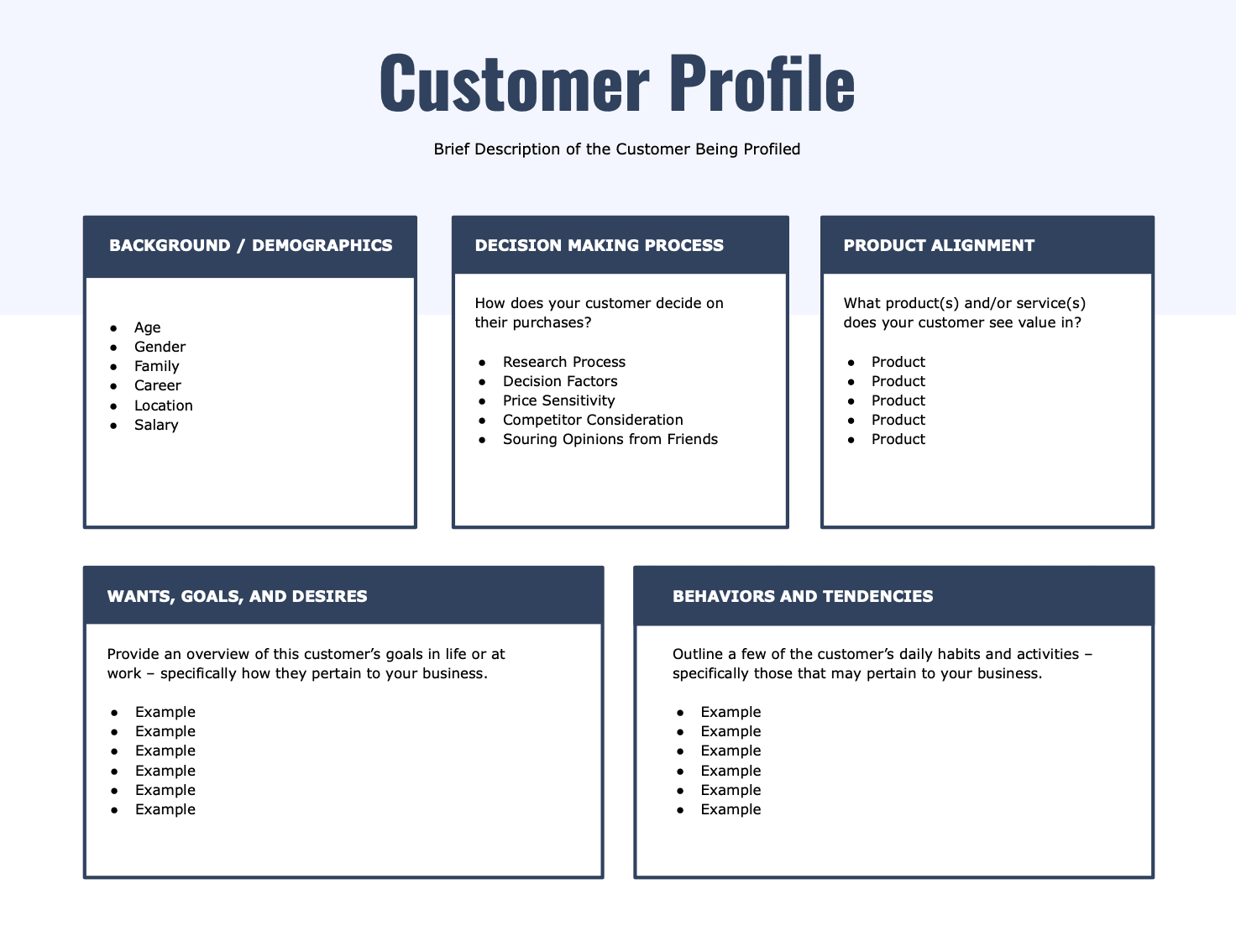
Hierarchical customer profile template
A great way for your sales team to score leads and prioritize outreach is to compare them against a hierarchy of fitness. That is, you create several customer profiles that indicate different levels of fit for your company, with the most complete fit being your ideal customer profile.
This customer profile template example follows that approach. It includes a “no fit” profile — also known as a negative persona — where you can detail behaviors, characteristics, or demographics that determine when a potential customer isn’t a great fit for your company.
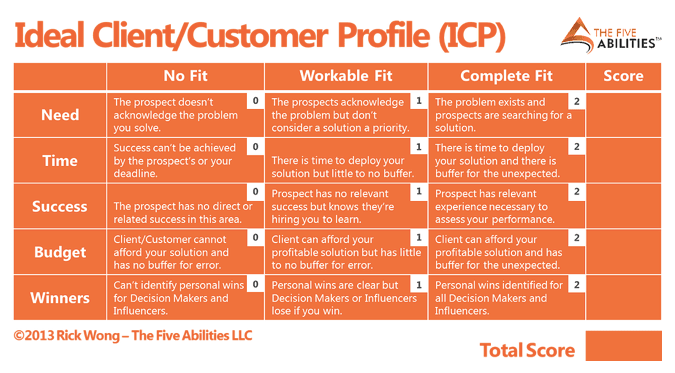
Visual customer profile template
This customer profile template is another one that takes a straightforward approach and lays out the required information in a clear, visual format. Your sales and customer service teams may find it helpful to include a stock image or caricature of your ideal customer to help them visualize who they’re talking to — this can be particularly helpful for employees who only engage with customers over the phone.
At the bottom of the template, you have the opportunity to write a brief description of your customer. Narrative approaches like this make information easier to digest, making your customer profiles more relatable.
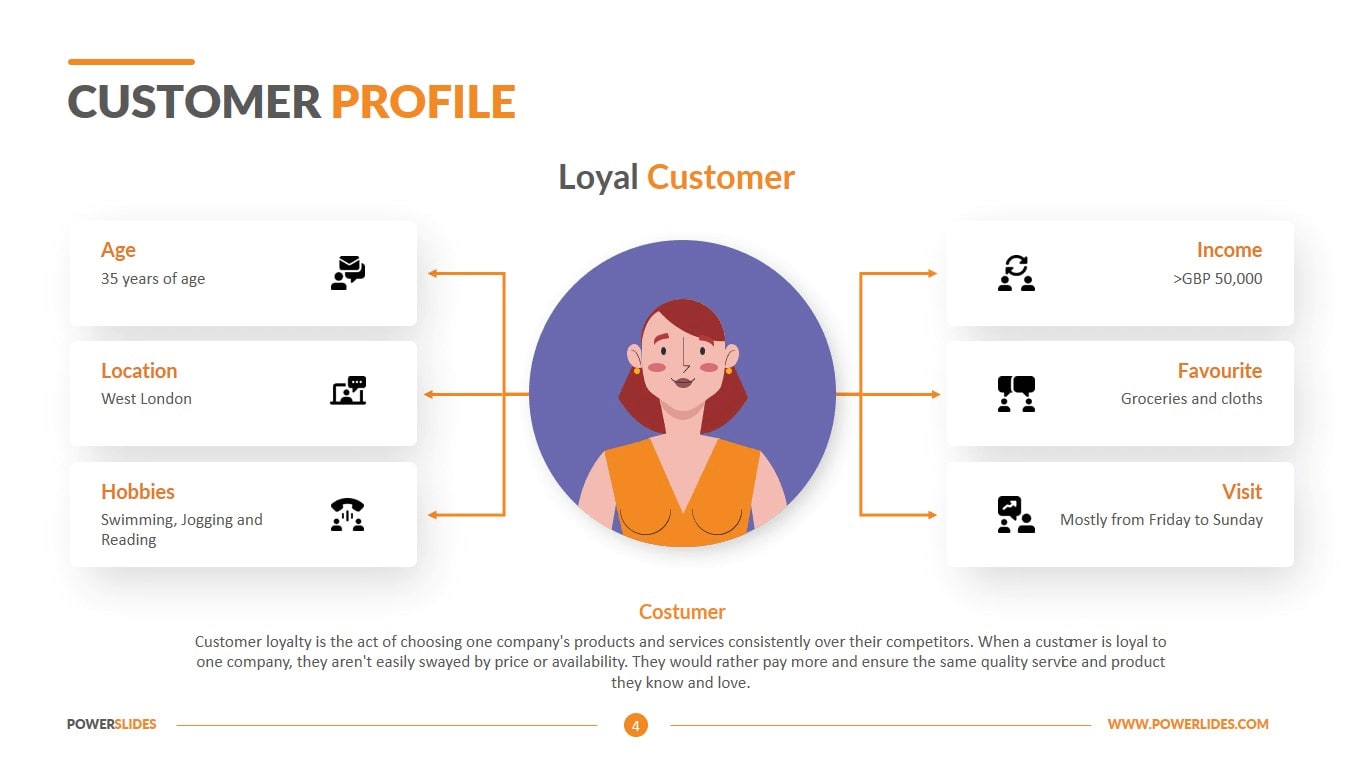
How monday CRM can help you create a comprehensive customer profile
Customer relationship management (CRM) systems, like monday CRM, enable you to analyze your existing customer data more effectively, identify patterns, and derive actionable insights.
Here are the key steps in creating a comprehensive customer profile.
1. Collect customer data
Creating a customer profile begins with collecting detailed information about your current and potential customers, including:
- Demographic data — age, gender, location, income, education, etc.
- Psychographic data — values, interests, lifestyles, personalities, etc.
- Behavioral data — purchase history, product usage, channel preferences, etc.
- Feedback and survey responses directly from customers
- Website and social media analytics on customer interactions
You can leverage multiple data sources like your CRM, analytics tools, customer surveys and interviews, and third-party data providers to build a robust customer dataset.
For example, with monday CRM, you can keep records of your contact and account information and access all past interactions, deals, and projects associated with an account or contact in a visual format.
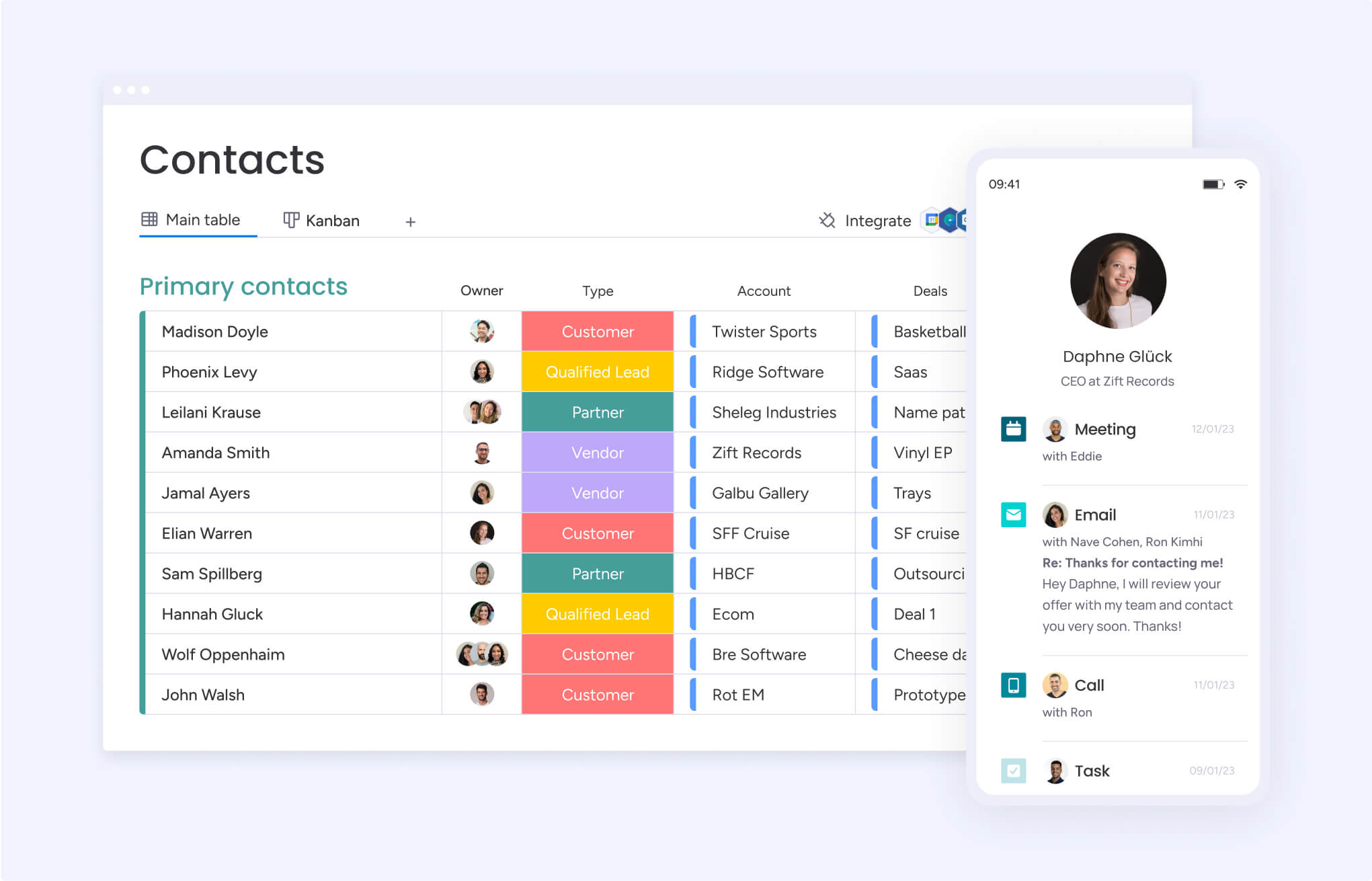
2. Analyze the data
Once you’ve collected your customer data, analyze it to identify patterns, segments, and key insights about your customers’ needs, motivations, behaviors, and preferences. Using the data analysis tools in monday CRM, you can access the customer insights you need with visual real-time dashboards and reports.
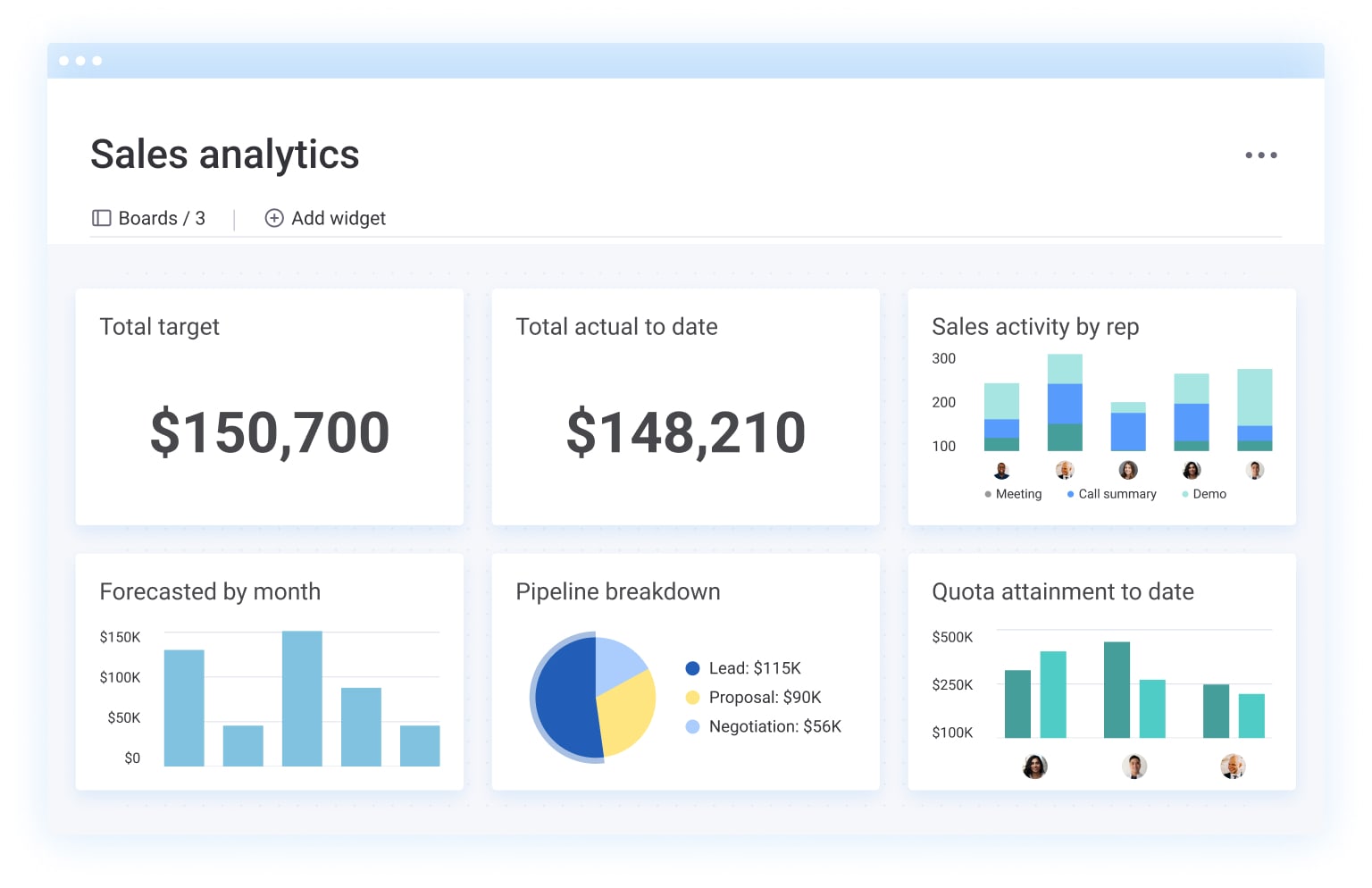
3. Identify customer segments
Based on your analysis, identify distinct customer segments that share similar characteristics, behaviors, and needs. Creating separate profiles for each key segment allows you to tailor strategies more effectively. Common ways to segment include demographics, psychographics, behaviors, buying journeys, and firmographics for B2B customers.
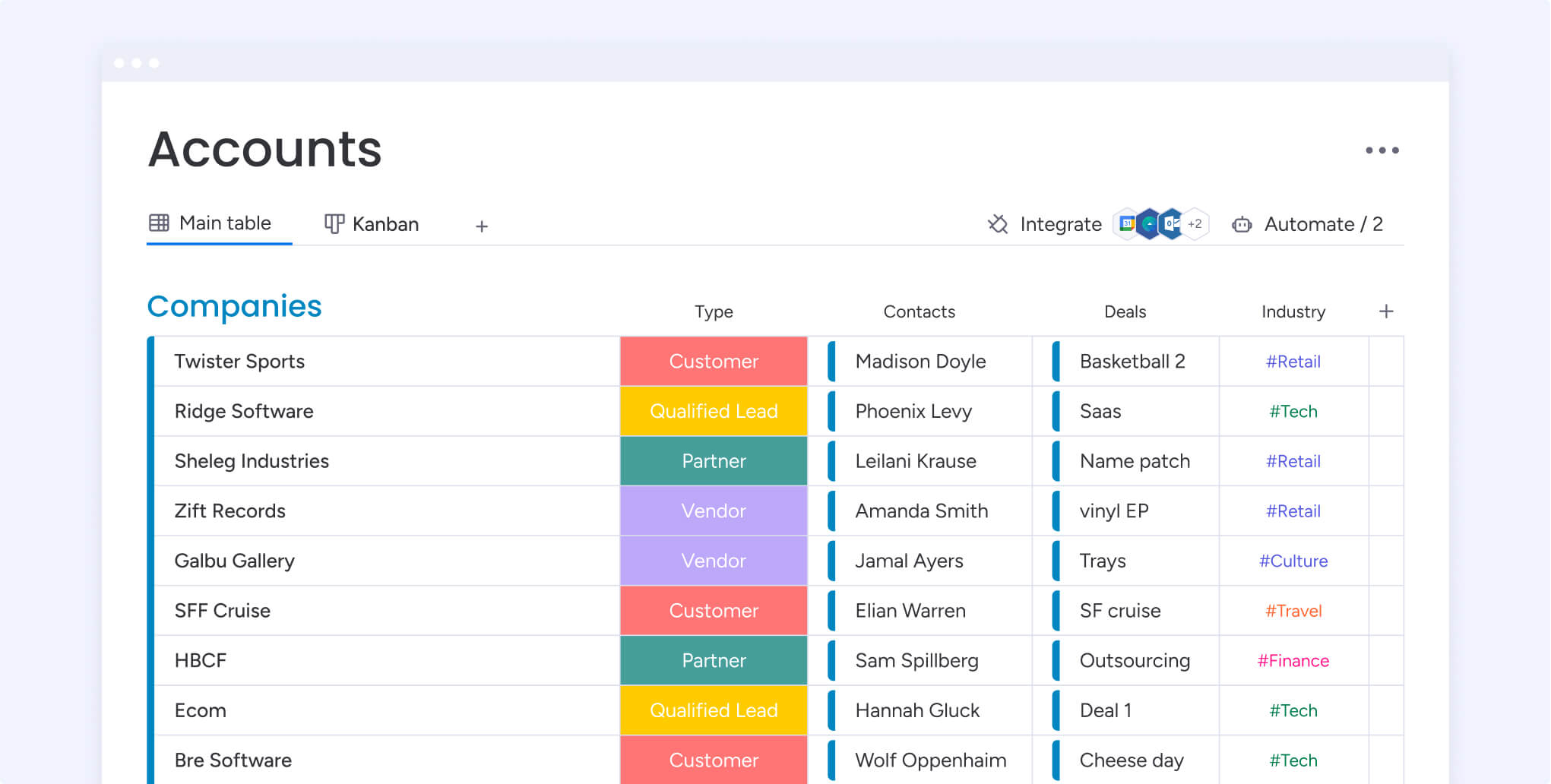
4. Build the customer profile
For each identified segment, create a detailed customer profile capturing the key demographic, psychographic, behavioral, and other relevant traits of that ideal customer group. Organize the information in an easy-to-reference format, such as a customer profile template or presentation deck, to facilitate sharing across teams.
Using our WorkCanvas integration, teams can quickly brainstorm,plan, visualize, and build customer profile templates on one collaborative whiteboard that syncs directly with monday.com. It’s an ideal way to save precious time by synchronizing all communications and feedback without switching bewtween platforms.
And with monday CRM, you get a consolidated single source of truth, so users from various teams can access the same information.
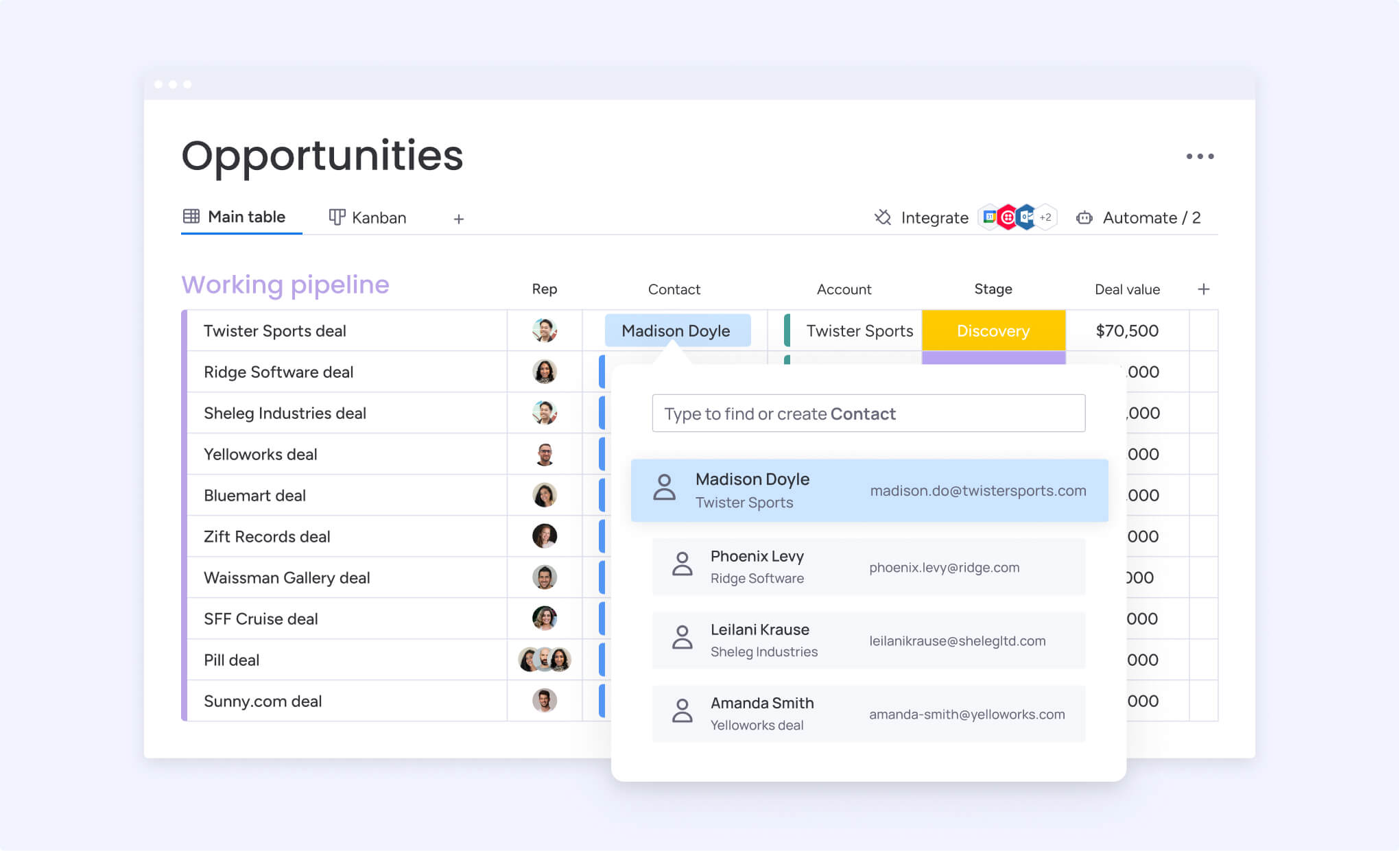
5. Share and update customer profiles
Share the completed customer profiles across marketing, sales, product, and service teams to align everyone around a common understanding of the customers. Regularly review and update the profiles as customer needs, behaviors, and market conditions evolve over time to ensure they remain accurate and actionable.
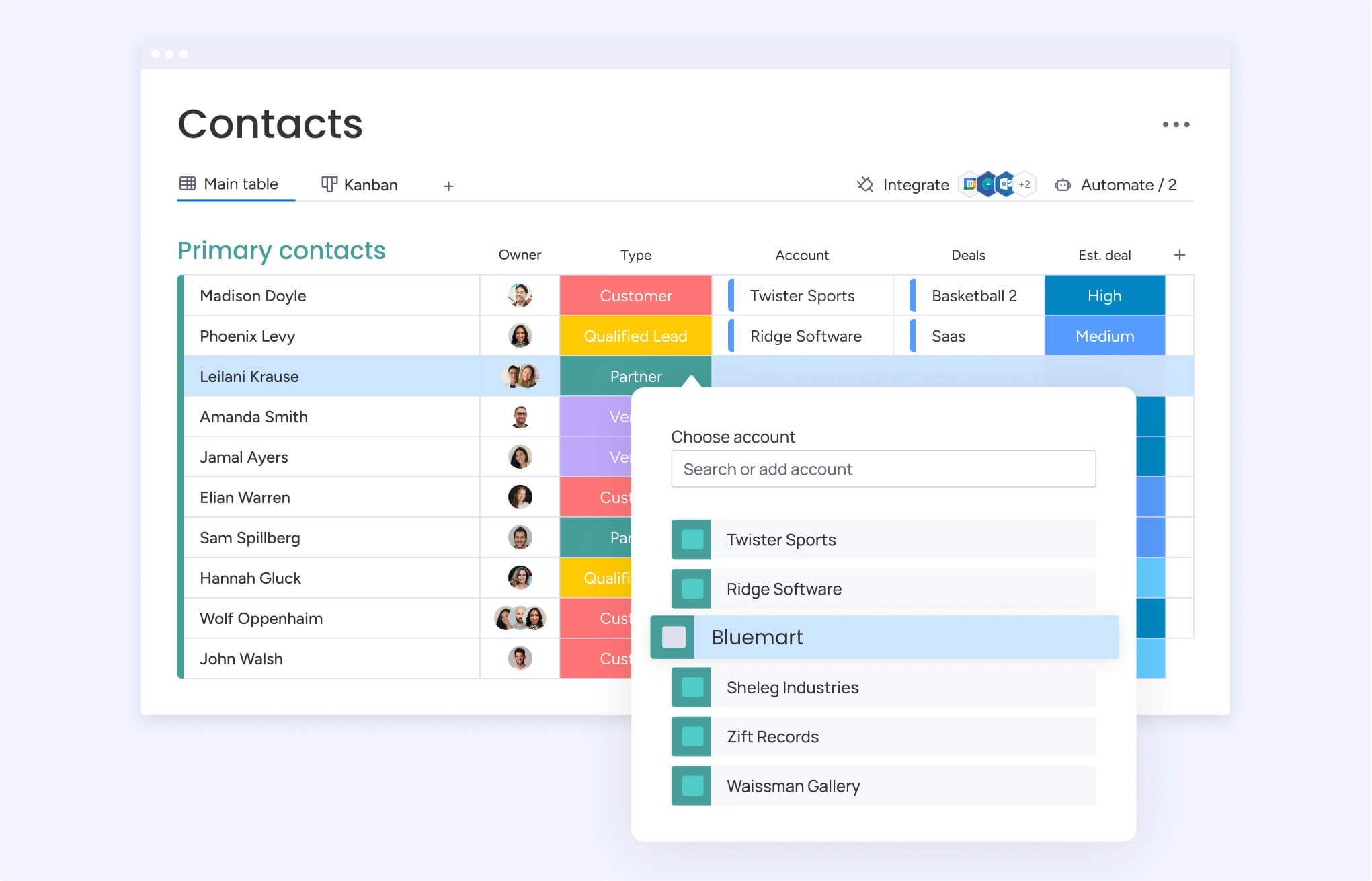
Build your ideal customer profile today
Creating customer profiles can be straightforward as long as you have the right tools. With monday CRM you get a single repository with all your customer data, where you can collaborate and build your customer profile templates visually.
Try monday CRM today with a 14-day free trial.
FAQs
How do I gather data for my customer profile?
You can gather data for your customer profiles by analyzing customer behavior on your CRM, website, and social media accounts, examining transactional data and purchase histories, and running customer surveys.
Can I have multiple customer profiles for different customer segments?
Yes, it's common for businesses to have multiple customer profiles for different segments. This allows you to tailor your marketing, products, and services more precisely to the needs of each distinct customer segment.
What are some common mistakes to avoid when creating a customer profile?
Some critical mistakes to avoid when creating a customer profile include relying too heavily on assumptions instead of actual customer data, failing to update profiles as your customers and market evolve, and having an incomplete profile that doesn't capture all relevant customer details like demographics, behaviors, preferences, and goals.
 Get started
Get started 
